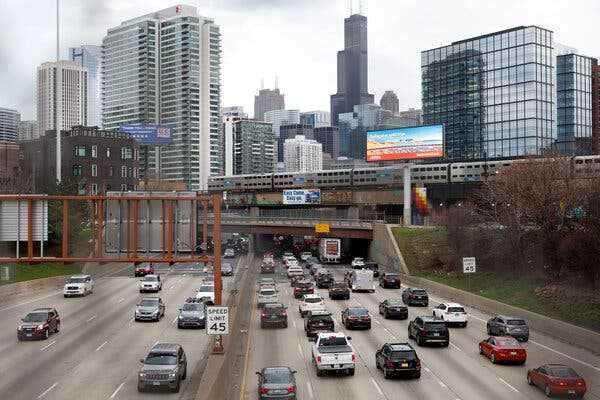The department said it would use new funding in the infrastructure law to carry out the strategy, which touches on issues ranging from speed limits to emergency medical care.

Traffic along Interstate 90 in Chicago. Traffic deaths have surged since the pandemic began.
WASHINGTON — The Transportation Department is embarking on a national strategy to tackle rising traffic fatalities using new funding in the $1 trillion infrastructure law, addressing issues ranging from speed limits and street lighting to emergency medical care.
In a 38-page report being released on Thursday, the department outlined an approach heavily dependent on working with states and local governments to address things like designing safer roads and reducing alcohol-impaired driving. The department also said it would issue federal guidance and create new programs to carry out the strategy, such as initiating rulemaking to require automatic emergency braking technology in new passenger vehicles.
The report comes as the number of traffic deaths across the country has soared, reversing some of the progress made over the past few decades. Although fewer people were on the road at the beginning of the pandemic, about 38,680 people died in motor vehicle crashes in 2020, an increase of about 2,500 from 2019, and deaths surged further in the first half of 2021. Officials have blamed more people speeding recklessly and using alcohol and drugs to cope with pandemic-related stress.
But the report also raises questions about how the federal government will carry out the strategy. The report calls the nation’s roadway network “highly complex” and points out that states and local governments have “significant levels of autonomy” to make decisions on roadway designs, locations and funding. The decentralized system has led to “disparate outcomes across localities and portions of the system, and complicates the landscape to address the roadway safety problem,” according to the report.
A senior department official said implementation of the programs would begin on Thursday, and many of the initiatives had target completion dates in 2024.
Pete Buttigieg, the transportation secretary, pointed to pots of funding in the infrastructure package over which his department has broad control. Although much of the funding is directly distributed to states, the package includes competitive grants that the federal government oversees, such as the Safe Streets and Roads for All program, a new $6 billion initiative that aims to reduce traffic fatalities.
“We’ve got to look at what’s working and lift up those communities and those jurisdictions that are doing the best job, in addition to finding measures and performance expectations that will hold those accountable who haven’t been keeping up,” Mr. Buttigieg said in an interview.
The secretary said the strategy signaled the department’s commitment to safety, which he called its top priority.
ImageA memorial where a cyclist was killed in December 2020 in the Bronx. The Transportation Department’s report said fatalities among pedestrians and bicyclists had risen faster than roadway fatalities overall in the past decade.Credit…Stephen Speranza for The New York Times
“The big first here is committing the department to the idea that only zero roadway deaths are acceptable, and then aligning all of our resources around that,” Mr. Buttigieg said.
Mr. Buttigieg said many communities were still living with the consequences of roads built with the “’50s or ’60s mentality” that roads were constructed for the “sole purpose of blasting vehicle traffic through as quickly as possible.” He said those communities could take a “sane approach to speed” by redesigning roadways, revising speed limits and installing speed bumps.
The report is broken down into five objectives: safer people, safer roads, safer vehicles, safer speeds and post-crash care. It calls on states and local governments to support research and develop technology to detect and prevent alcohol- and drug-impaired driving. It also directs the Federal Highway Administration to revise guidance to encourage safer speeds and the use of speed cameras.
Decreasing traffic fatalities can also reduce historical racial disparities. The report underscores the inequities in motor vehicle deaths, which disproportionately affect people of color. In 2020, traffic fatalities among Black people jumped by 23 percent from the year before, according to the National Highway Traffic Safety Administration. In comparison, traffic fatalities among white people increased by 4 percent during the same time period.
The department said its safety strategy was also critical for addressing the climate crisis. Improving safety on roadways may help achieve greenhouse gas reduction goals by increasing the use of public transit and making streets safer for pedestrians, according to the report.
“Fatalities among pedestrians and bicyclists have been increasing faster than roadway fatalities overall in the past decade, which has a chilling effect on climate-friendly transportation options such as walking, biking or taking public transportation,” the report said. “To unlock the climate benefits of those modes, we need road and street systems that feel safe and are safe for all road users.”
Source: nytimes.com



